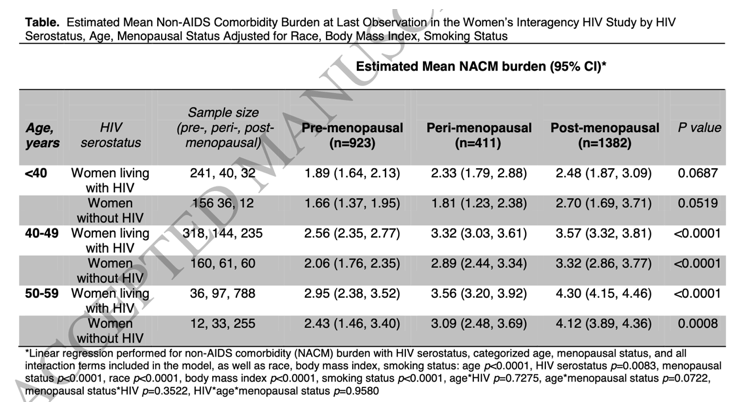| |
THE EFFECT OF MENOPAUSAL STATUS, AGE, AND HIV
ON NON-AIDS COMORBIDITY BURDEN AMONG U.S. WOMEN
|
| |
| |
Clinical Infectious Diseases, 10 June 2022
Download the PDF here
Lauren F. Collins, MD1,2, C. Christina Mehta, PhD, MSPH1, Frank J. Palella, Jr., MD3, Yetunde
Fatade, MD4, Susanna Naggie, MD5, Elizabeth T. Golub, PhD6, Kathryn Anastos, MD7, Audrey
L. French, MD8, Seble Kassaye, MD9, Tonya N. Taylor, PhD10, Margaret A. Fischl, MD11, Adaora
A. Adimora, MD12, Mirjam-Colette Kempf, PhD, MPH13, Phyllis C. Tien, MD14, Anandi N. Sheth,
MD1,2, Ighovwerha Ofotokun, MD1,2
Abstract
Menopause may impact the earlier onset of aging-related comorbidities among women with versus without HIV. We found that menopausal status, age, and HIV were independently associated with higher comorbidity burden; and that HIV impacted burden most in the pre-/peri-menopausal phases.
Introduction
Women living with HIV (WLWH) are living longer and an increasing number are reaching
menopause. From 2014 to 2018, HIV diagnoses increased by 5% among women ≥55 years
old1. In this growing population of aging WLWH, unique biologic and psychosocial factors may
affect the senescence process, including the menopausal transition and development of non-
AIDS comorbidities (NACM).
Menopause is characterized by estrogen depletion, resulting from aging-related declines in
ovarian reserve, and is associated with an increased risk of cardiovascular disease (CVD),
osteoporosis, and other NACM2. WLWH may experience menopause earlier and with greater
symptom intensity than the general female population; however, studies are inconsistent and
inconclusive3. HIV-related inflammatory effects on the neuroendocrine axis have the potential to
impact menopause timing and severity4,5. Further, the menopausal transition among WLWH
may also be affected by antiretroviral exposure and a high prevalence of substance use, viral
coinfections, and socioeconomic hardship in this population6.
Leveraging the Women's Interagency HIV Study (WIHS), we previously showed that WLWH
versus women without HIV had a higher burden of 10 aging-related NACM overall and
specifically among those aged 40-49 and ≥60 years, and had a significantly earlier incidence of
NACM7,8. Mechanisms by which menopause may affect the natural history of aging-related
NACM among WLWH remain largely unknown; thus, we evaluated whether HIV modifies the
effects of age and menopausal status on comorbidity burden.

|
|
| |
| |
|
|
|